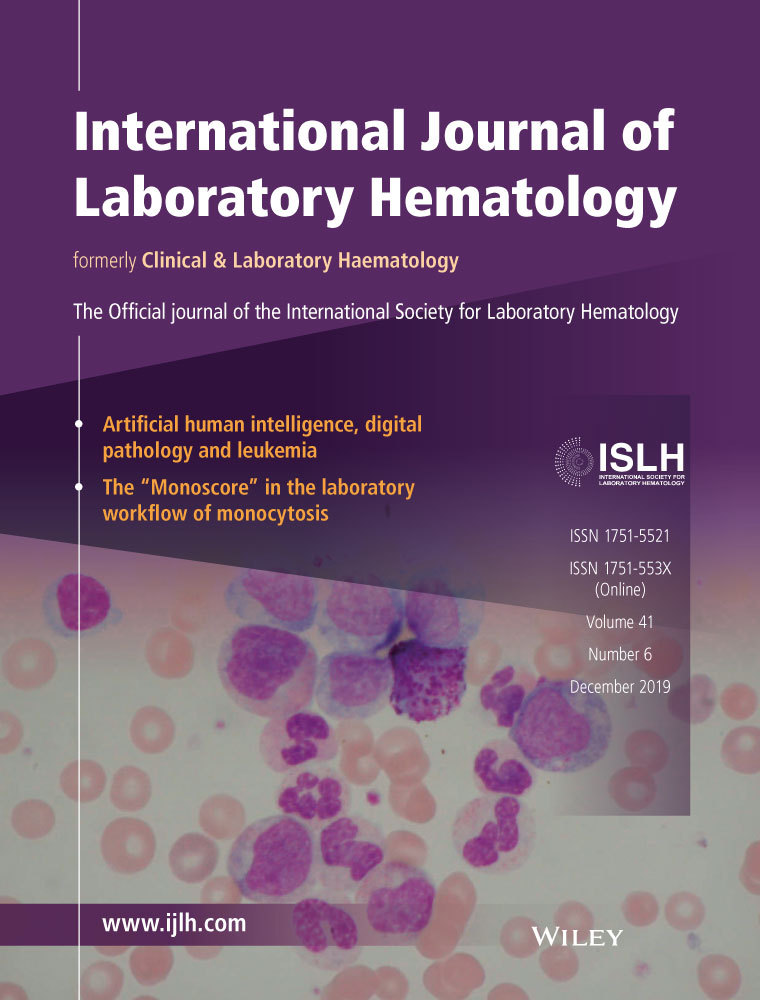Comparison of real-time PCR vs PCR with fragment length analysis for the detection of CALR mutations in suspected myeloproliferative neoplasms
Laura J. Doyle
Pathology and Laboratory Medicine Institute, Cleveland Clinic, Cleveland, Ohio
Search for more papers by this authorBryan L. Betz
University of Michigan School of Medicine, Ann Arbor, Michigan
Search for more papers by this authorHelmut C. Weigelin
University of Michigan School of Medicine, Ann Arbor, Michigan
Search for more papers by this authorGary W. Procop
Pathology and Laboratory Medicine Institute, Cleveland Clinic, Cleveland, Ohio
Search for more papers by this authorCorresponding Author
James R. Cook
Pathology and Laboratory Medicine Institute, Cleveland Clinic, Cleveland, Ohio
Correspondence
James R. Cook, Department of Laboratory Medicine, Cleveland Clinic, 9500 Euclid Ave, Desk L30, Cleveland OH, 44195.
Email: [email protected]
Search for more papers by this authorLaura J. Doyle
Pathology and Laboratory Medicine Institute, Cleveland Clinic, Cleveland, Ohio
Search for more papers by this authorBryan L. Betz
University of Michigan School of Medicine, Ann Arbor, Michigan
Search for more papers by this authorHelmut C. Weigelin
University of Michigan School of Medicine, Ann Arbor, Michigan
Search for more papers by this authorGary W. Procop
Pathology and Laboratory Medicine Institute, Cleveland Clinic, Cleveland, Ohio
Search for more papers by this authorCorresponding Author
James R. Cook
Pathology and Laboratory Medicine Institute, Cleveland Clinic, Cleveland, Ohio
Correspondence
James R. Cook, Department of Laboratory Medicine, Cleveland Clinic, 9500 Euclid Ave, Desk L30, Cleveland OH, 44195.
Email: [email protected]
Search for more papers by this author
REFERENCES
- 1Vainchenker W, Kralovics R. Genetic basis and molecular pathophysiology of classical myeloproliferative neoplasms. Blood. 2017; 129: 667-679.
- 2Tefferi A, Vannucchi AM. Genetic risk assessment in myeloproliferative neoplasms. Mayo Clin Proc. 2017; 92: 1283-1290.
- 3Klampfl T, Gisslinger H, Harutyunyan AS, et al. Somatic mutations of calreticulin in myeloproliferative neoplasms. N Engl J Med. 2013; 369: 2379-2390.
- 4Nangalia J, Massie CE, Baxter EJ, et al. Somatic CALR Mutations in Myeloproliferative Neoplasms with Nonmutated JAK2. N Engl J Med. 2013; 369: 2391-2405.
- 5Pietra D, Rumi E, Ferretti VV, et al. Differential clinical effects of different mutation subtypes in CALR-mutant myeloproliferative neoplasms. Leukemia. 2016; 30: 431-438.
- 6Jones AV, Ward D, Lyon M, et al. Evaluation of methods to detect CALR mutations in myeloproliferative neoplasms. Leuk Res. 2015; 39: 82-87.
- 7Lim K-H, Lin H-C, Chen CG-S, et al. Rapid and sensitive detection of CALR exon 9 mutations using high-resolution melting analysis. Clin Chim Acta. 2015; 440: 133-139.
- 8Chi J, Manoloukos M, Pierides C, et al. Calreticulin mutations in myeloproliferative neoplasms and new methodology for their detection and monitoring. Ann Hematol. 2015; 94: 399-408.
- 9Murugesan G, Guenther-Johnson J, Mularo F, Cook JR, Daly TM. Validation of a molecular diagnostic assay for CALR exon 9 indels in myeloproliferative neoplasms: identification of coexisting JAK2 and CALR mutations and a novel 9 bp deletion in CALR. Int J Lab Hematol. 2016; 38: 284-297.
- 10Arber DA, Orazi A, Hasserjian R, et al. The 2016 revision to the World Health Organization classification of myeloid neoplasms and acute leukemia. Blood. 2016; 127: 2391-2406.




